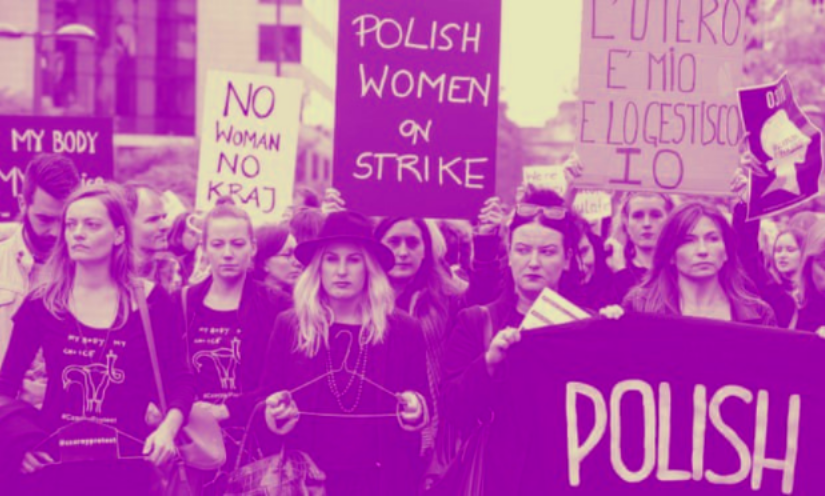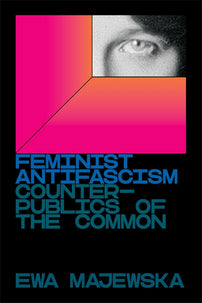Ewa Majewska on the success of Poland's women’s protests in 2016
How the 2016 women’s protests situated reproductive rights within the context of labor rights and class composition.

An excerpt from Feminist Antifascism: Counterpublics of the Common by Ewa Majewska. Subscribe to the Verso Book Club at the Subscriber or Comrade level in July to get a copy of Feminist Antifascism as part of your subscription.
***
The women’s protests in Poland since 2016 have built a transversal movement. They explore patterns of resistance through various forms and styles, old and new, as they reference the nineteenth-century women’s protests (hence the black clothes); the women’s strike, inspired by the 1975s women’s strike in Iceland, but also by the Polish strikes of 1905, 1971 and 1980, where women were particularly active, as well as the 2007 “White Protests” of the nurses. They have also used social media and networking, organizing in ways inspired by Solidarność, the legendary workers' union. To my mind, this connection between reproductive rights and labor successfully deflated the myth that feminism is a solely middle-class movement.
Before 2016, women’s and feminist organizations existed in Poland, and they sometimes gained great visibility. There are at least ten gender studies programs in various Polish universities, and some thousand registered non-governmental organizations at least mentioning the rights of women in their programs. The feminist movement has been very vocal in the last twenty years, engaging with abortion and reproductive politics, violence against women, politics, labor, culture and other spheres. However, the majority of registered and grassroots organizations are located in big cities or towns, and their members often belong to the urban, educated middle-class.
As the 2016 women’s protests began as a reaction to the bills restricting the already harsh antiabortion Polish law, I need to offer some highlights of the reproductive rights battles as well as those more generally concerning gender. Under Poland’s current law, abortion is legal only in three cases: when the pregnancy was the result of rape; when the fetus shows risks of severe damage or illness; or when the life of the woman is endangered. Unfortunately, even under these conditions women often do not obtain permission to terminate their pregnancies, usually because of the doctor’s convictions, which generally leads them either to illegal abortions, in Poland or abroad, or to risk their lives and give birth. The bill, against which the Black Protests have been held since 2016, would make abortion completely illegal and would allow authorities to sentence women to prison for up to two years.
I want to emphasize the necropolitical aspect of the antiabortion campaigns and legal proposals that have been presented since 2016. In October 2016, the head of the Conservative Party (PiS), Jarosław Kaczyński, declared: “We want women to give birth even in cases when the child is deformed. We want such children to be baptized, buried, to have a name.” There was wide media commentary on this statement, effectively spreading panic among women. Kaczyński declaration clearly places the life of the fetus above the life, health and well-being of the woman. It also suggests that in discussions about pregnancy, women can be omitted, we can be stripped of any rights, presence, or even visibility. The panic resulting from this particular statement was backed up by the fact that since 2015, Kaczyński’s party has had a parliamentary majority. This means PiS (Prawo i Sprawiedliwość) could— with the support of right-wing allies, but also with the votes of some supposed liberals who are actually conservative— change the law and make abortion completely illegal.
Mobilizing women against further restrictions on abortion began in early 2016, first in preexisting women’s and feminist organizations. Massive demonstrations spread across the country, unifying women across class, political persuasion and rural-urban divides under one general umbrella: that of women’s rights and dignity. Polish communities mobilized globally, and feminists from other countries joined in as well. As feminist groups in Italy, Mexico and Argentina were likewise planning demonstrations for fall 2016, mainly to protest violence against women, it was easy to network and combine the protests— and this is how the International Women’s Strike began. Women in South Korea also protested in Seoul against the antiabortion laws in their country, using the Black Protest name and banners in solidarity with us in Poland. The women in the United States started their anti-Trump protests in Winter 2016–17, and feminists from other countries, inspired by what was already happening, started to join, spreading the International Women’s Strike to some seventy countries by 2018.
In April 2016, 100,000 women joined ad hoc Polish social media group Gals for Gals (Dziewuchy Dziewuchom) practically overnight. Local branches of this group started popping up as the protests developed, and from within these branches new leaders and activists appeared, often without any prior experience with activism and politics. The #blackprotests social media campaign was initiated on September 23, 2016, by a member of the left-wing Razem Party, Gocha Adamczyk. Eventually it became the biggest thing on the Polish internet. The idea was to post a black-and-white selfie together with the hashtag #blackprotest (#czarnyprotest). Between September 23 and 24, some 150,000 such selfies were posted online, while the hashtag #czarnyprotest was used some 8 million times on social media.
Many who demonstrated against the antiabortion bill in fall 2016 did so after “posting” their support online. Thus, for many women and LGBTQ+ people, as well as for some men, the “engaged selfie” and hashtag became an intermediary step between complete lack of involvement in politics and demonstrating in the streets. Clearly, this was a very powerful use of social media and the internet for the cause of the feminist protest. Moreover, it proved that social media actually can be used to mobilize and engage protestors, not just to appease them. This can also be an argument for “selfie-feminism,” which in some part tends to follow a mainstream agenda; yet, in other cases, it effectively weakens and contradicts patriarchal abuse of women and LGBTQ+ people. Further online feminist actions, such as the #MeToo campaign and other hashtags show how within internet cultural industries mainly aimed at profit, some solidarity, protest or resistance actions are nonetheless possible.
In September 2016, famous Polish actress Krystyna Janda declared that women should begin a strike in response to the threat of the full ban on abortion. This statement became viral, and even the popular women’s press started to write about the Women’s Strike in Iceland in 1971 and other women’s protests, thus making it “common” and “normal” for women to join protests. This suggestion of striking introduced by Janda in the narrative of protest tacitly shifted the priorities of the feminist movement in 2016. The economy of reproductive labor, an invisible topic in the perspective established by liberal feminism on the abortion question— namely that focusing on choice— shifted toward the economy of the abortion ban, basically becoming another element of the sharpening class division between those who can and cannot afford abortion.
Before 2016, it was quite difficult to discuss the economics of the abortion ban. This shift from the liberal preoccupation with “choice” toward a more socialist focus on the class composition of women as a group made the feminist narrative stronger and more compelling for the social masses. I believe this turn was crucial for mass participation in the protests. The production of the exceptional commodity— the labor force or, to put it even more bluntly, humans— is most commonly excluded from money-mediated exchanges, and thus pushed out of the supposedly main Marxist focus on value production. However, as various currents of feminism rightly point out, especially in this time of cognitive capitalism and growing precarization, reproductive labor has become one of the central elements of capitalist production, as a form of work that is increasingly central to monetarized exchanges, as well as in its uniquity, caused, among other reasons, by the neoliberal withdrawal of states and employers from their responsibilities in health care and social services. As various aspects of the social realm can be explained or at least critically addressed by the tools of Social Reproduction Theory, reproduction became a key context in understanding the majority of social experiences, including those previously seen solely as aspects of intimate life or paid labor.

